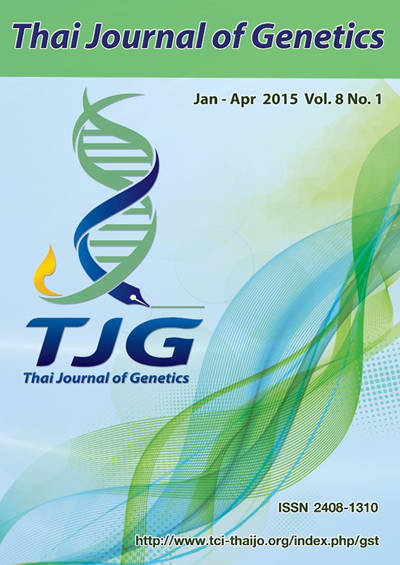การพัฒนาเครื่องหมายดีเอ็นเอที่จำเพาะต่อยีน BADH2 ในถั่วเหลืองฝักสด (Development of allele specific marker for BADH2 gene in vegetable soybeans)
DOI:
https://doi.org/10.14456/tjg.2015.6Keywords:
ยีน BADH2, ถั่วเหลืองฝักสด, กลิ่นหอม, เครื่องหมายดีเอ็นเอที่เฉพาะเจาะจงกับยีน, สาร 2AP, BADH2 gene, vegetable soybean, aroma, allele specific marker, 2APAbstract
Aroma is an important trait in vegetable soybeans for value added quality. This character is controlled by betaine aldehyde dehydrogenase 2 (BADH2) gene. Mutation in BADH2 enzyme prevents the conversion of gamma-aminobutyraldehyde (GABald) to gamma amino butyric acid (GABA), instead, GABald in the mutant soybean is converted to 2-acetyl-1-pyrroline (2AP) responsible for aroma in vegetable soybean. The objective of this research was to develop allele specific marker for BADH2 gene. Analysis of BADH2 sequence of “Kaori” showed 2-bp deletion of TT in exon 10. Amino acid sequence analysis suggested that TTT codon coding for phenylalanine was replaced by TGA as the stop codon causing aroma. Allele specific marker was designed to obtain sharp and clear bands using the annealing temperature of 62°C and primers concentration for outer-F, inner-F, inner-R and outer-R as 0.25 µM, 0.4 µM, 0.1 µM, and 0.25 µM respectively. This technique can be applied to detect aromatic, non-aromatic and heterozygous genotypes of individuals in an F2 population.
กลิ่นหอมเป็นลักษณะที่มีความสำคัญของถั่วเหลืองฝักสดทำให้สามารถเพิ่มมูลค่าทางการตลาดได้ ยีน BADH2 ควบคุมความหอม ซึ่งในถั่วเหลืองฝักสดพันธุ์หอมไม่มีเอนไซม์ BADH2 เนื่องจากเกิดการกลายของยีน BADH2 ทำให้เอนไซม์ที่สังเคราะห์ขึ้นไม่สมบูรณ์
ไม่สามารถเปลี่ยนสาร gamma-aminobutyraldehyde (GABald) เป็นสาร gamma-aminobutyric acid (GABA) ได้ แต่สารดังกล่าวจะถูกเปลี่ยนเป็นสาร 1-pyrroline
และเปลี่ยนเป็นสาร 2-acetyl-1-pyrroline (2AP) ซึ่งทำให้มีกลิ่นหอม งานวิจัยครั้งนี้มีวัตถุประสงค์เพื่อพัฒนาเครื่องหมายดีเอ็นเอแบบ allele specific marker ให้เฉพาะเจาะจงกับยีน BADH2 จากการวิเคราะห์ลำดับ
นิวคลีโอไทด์ของยีน BADH2 พบว่า พันธุ์ Kaori เกิดการกลายแบบขาดหายไป (deletion) จำนวน 2 นิวคลีโอไทด์ คือ TT ใน exon 10 และการเปรียบเทียบลำดับกรด
อะมิโนในยีน BADH2 พบว่า พันธุ์ Kaori โคดอนเปลี่ยนจาก TTT เป็น TGA จึงทำให้กรดอะมิโนเปลี่ยนจาก phenylalanine เป็น stop codon ทำให้มีกลิ่นหอม
การออกแบบและทดสอบเครื่องหมายดีเอ็นเอ แบบ allele specific marker พบว่า ปฏิกิริยาพีซีอาร์สภาวะที่เหมาะสม ที่อุณหภูมิ annealing เท่ากับ 62 องศาเซลเซียส และความเข้มข้นของไพรเมอร์ outer-F, inner-F, inner-R และ outer-R เท่ากับ 0.25, 0.4, 0.1 และ 0.25 ไมโครโมลาร์ ตามลำดับ ทำให้ปรากฏแถบดีเอ็นเอได้ชัดเจน และได้นำมาทดสอบกับประชากรชั่วรุ่นที่ 2 ที่มีการกระจายตัวของยีนความหอม สามารถตรวจสอบ ต้นถั่วเหลืองฝักสดที่หอม ไม่หอม และเฮเทอโรไซกัสได้
References
ธงชัย จันทร์จู สมพงศ์ จันทร์แก้ว เรืองชัย จูวัฒนสำราญ พีระศักดิ์ ศรีนิเวศน์ ประกิจ สมท่า (2554) การยืนยันการถ่ายทอดลักษณะความหอมและเครื่องหมายดีเอ็นเอที่เชื่อมโยงกับความหอมในถั่วเหลืองฝักสดพันธุ์ “Chamame”. แก่นเกษตร 39 ฉบับพิเศษ 3 : 78–82.
นัฐภัทร์ คำหล้า (2553) ถั่วเหลืองฝักสด แหล่งโปรตีน ราคาถูก. (ระบบออนไลน์). http://nsfcrcnews .blogspot.com/2010/08/blog-post_16.html (15 ธันวาคม 2557)
พรพันธ์ ภู่พร้อมพันธุ์ (2538) เทคนิคการจําแนกพันธุ์พืชด้วยวิธี Random Amplified Polymorphic DNA (RAPD). น. 39–60. เอกสารประกอบการฝึกอบรมทางวิชาการ เรื่องการตรวจแยกสายพันธุ์พืชด้วย การใช้ Isozyme pattern และ RAPD ครั้งที่ 1 ณ ฝ่ายปฏิบัติการวิจัยและเรือนปลูกพืชทดลอง มหาวิทยาลัยเกษตรศาสตร์ วิทยาเขตกําแพงแสน. นครปฐม.
เรืองชัย จูวัฒนสำราญ สุภักตร์ ปัญญา ดรุพัน แสนศิริพันธ์ (2552) มาตรฐานคุณภาพถั่วเหลืองฝักสดเพื่อการส่งออก. ว. แม่โจ้ปริทัศน์. 10: 13–17.
Bradbury LM, Gillies SA, Brushett DJ, Waters DL, Henry RJ. (2008) Inactivation of an amino aldehyde dehydrogenase is responsible for fragrance in rice. Plant Mol Biol 68: 439–449.
Doyle JJ, Doyle JL (1987) A rapid DNA isolation procedure for small quantities fresh leaf tissue. Phytochem Bull 19: 11–15.
Fushimi T, Masuda R (2001) 2-acetyl-1-pyrroline concentration of the vegetable soybean. P.39. In: Lumpkin T, Shanmugasundaram S (eds) Proceeding of the 2nd 338 international vegetable soybean conference. Washington State University, Pullman, Washington, USA.
Juwattanasomran R, Somta P, Chankaew S, Shimizu T, Wongpornchai S, Kaga A, Srinives P (2010a) A SNP in GmBADH2 gene associated with fragrance in vegetable soybean variety “Kaori” and SNAP marker development for the fragrance. Theor App. Genet 122: 533–541.
Juwattanasomran R, Somta P, Kaga A, Chankaew S, Shimizu T, Wongpornchai S, Srinives P (2010b) Identification of a new fragrance allele in soybean and development of its functional marker. Mol Breed 29: 13–21.
Ramkumar G, Sivaranjani AKP, Pandey Mannisk K, Sakthivel K., Shobha Rani N., Sudarshan I., Prasad GSV, Neeraja CN, Sundaram RM, Viraktamath BC, Madhav MS (2010) Development of a PCR-based SNP marker system for effective selection of kernel length and kernel elongation in rice. Mol Breed 26: 735–740.
Wanchana S, Kamolsukyunyong W, Ruengphayak S, Toojinda T, Tragoonrung S, Vanavichit A (2005) A rapid construction of a physical contig across a 4.5 cM region for rice grain aroma facilitates marker enrichment for positional cloning. ScienceAsia, 31: 299–306.



